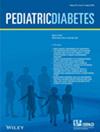ISPAD临床实践共识指南2022:儿童和青少年1型糖尿病的分期。
IF 3.9
3区 医学
Q2 ENDOCRINOLOGY & METABOLISM
引用次数: 40
摘要
本文章由计算机程序翻译,如有差异,请以英文原文为准。
ISPAD Clinical Practice Consensus Guidelines 2022: Stages of type 1 diabetes in children and adolescents.
The stages of type 1 diabetes (T1D) provide common ground for global efforts to prevent DKA and delay progression to disease in children and adolescents: An ISPAD consensus guideline. with normal glucose tolerance (via OGTT); Stage 2=multiple AAb-positive with abnormal glucose tolerance; Stage 3=clinical diagnosis of T1D
求助全文
通过发布文献求助,成功后即可免费获取论文全文。
去求助
来源期刊

Pediatric Diabetes
医学-内分泌学与代谢
CiteScore
6.60
自引率
14.70%
发文量
141
审稿时长
4-8 weeks
期刊介绍:
Pediatric Diabetes is a bi-monthly journal devoted to disseminating new knowledge relating to the epidemiology, etiology, pathogenesis, management, complications and prevention of diabetes in childhood and adolescence. The aim of the journal is to become the leading vehicle for international dissemination of research and practice relating to diabetes in youth. Papers are considered for publication based on the rigor of scientific approach, novelty, and importance for understanding mechanisms involved in the epidemiology and etiology of this disease, especially its molecular, biochemical and physiological aspects. Work relating to the clinical presentation, course, management and outcome of diabetes, including its physical and emotional sequelae, is considered. In vitro studies using animal or human tissues, whole animal and clinical studies in humans are also considered. The journal reviews full-length papers, preliminary communications with important new information, clinical reports, and reviews of major topics. Invited editorials, commentaries, and perspectives are a regular feature. The editors, based in the USA, Europe, and Australasia, maintain regular communications to assure rapid turnaround time of submitted manuscripts.
 求助内容:
求助内容: 应助结果提醒方式:
应助结果提醒方式:


